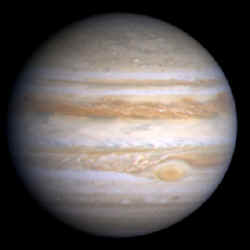Spontaneous Cold Plasma

Until recently, a “cold” plasma–a gas of ionized atoms–was anything cooler than 10,000 K. But within the last year, atomic physicists have begun creating and studying plasmas at temperatures approaching absolute zero. Now a team of researchers reports in the 20 November PRL that ultracold atoms with electrons in highly excited states can spontaneously evolve into ultracold plasmas. These plasmas may serve as simple systems to help researchers better understand the plasmas found in white dwarf stars and the interiors of massive planets.
Plasmas in this new breed are “strongly coupled,” that is, the motion of the ions and electrons is controlled mostly by their mutual attraction. In “classical” hot plasmas, such as that found in the sun, particles more often fly past one another with little interaction. But warm regions can also harbor strongly coupled plasmas if the density is high enough; the center of Jupiter is thought to be such a place.
Thomas Gallagher of the University of Virginia in Charlottesville and his colleagues have been studying how cold, highly excited atoms behave in electric fields. These “Rydberg” atoms are created by exciting an outer electron to a distant, weakly bound orbital. The radius of a cesium Rydberg atom is about 1600 Å, says Gallagher. “They’re enormous atoms.”
Now he and a group led by Pierre Pillet of the National Center for Scientific Research in Orsay, France, have found that if the density is great enough, these cold atoms spontaneously evolve into plasmas. The highly excited electrons, initially bound to individual ions, lose track of which ion they started with and end up as a cloud of electrons bound to a cloud of ions–a plasma.
Pillet and Gallagher cooled clouds of rubidium or cesium atoms using lasers and trapped them in a magneto-optical trap. They used laser pulses to excite the electrons to a Rydberg state. Gallagher explains that the majority of the atoms in the trap were cooled to a temperature just above absolute zero (140 to 300 µK), but about 1% of the atoms in the trap were hot (room temperature, 300 K). Within a few microseconds, the Rydberg cloud spontaneously evolved into a plasma.
Gallagher believes that collisions between the cold and hot Rydberg atoms are important for the transition, since trapped cold atoms alone do not spontaneously evolve into a plasma. There is also some level of background ionization of Rydberg atoms, due to thermal photons in the cloud, and hot atoms increase the rate of ionization. The plasma forms when enough cold ions have been generated to trap the electrons produced by ionization.
But Gallagher and Pillet still don’t know where the energy comes from to produce the plasma. They estimate that collisions with hot atoms and ionization from thermal photons account for at most about 10% of the energy needed to separate the charges and create the plasma. Their next experiments will address this missing energy puzzle.
Steve Rolston, of the National Institute for Standards and Technology (NIST) in Gaithersburg, MD, led the group that created the first ultracold plasmas, just over a year ago. He says ultracold plasmas are a new realm. “The distinction between a cloud of atoms and a plasma starts to become lost to some extent,” he says. “It’s probing that interface between single-body physics–thinking of each atom individually–and many-body physics, or collective effects.” Rolston calls it exploratory physics. “We don’t know what to expect and there’s actually very little theory to aid us.”
–Diana Steele
Diana Steele is a freelance science writer based in San Diego.
More Information
The first ultracold plasma was reported in Phys. Rev. Lett. 83, 4776 (1999).


